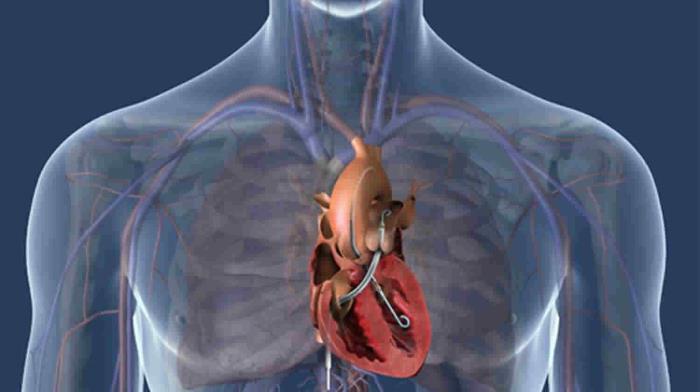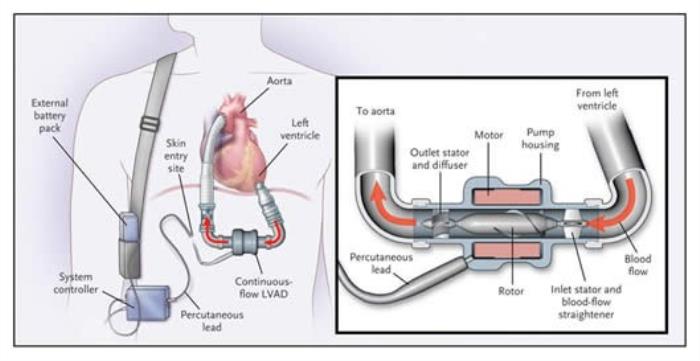Left Ventricular Assist Devices (LVADs) are commonly used in patients with advanced heart failure, including those with congenital heart defects. These devices help manage the severe impacts of congenital heart issues by providing mechanical support to the heart. In some cases, LVAD surgery is necessary to stabilize heart function, especially when traditional treatments are no longer effective. This procedure may serve as a bridge to heart transplant or long-term therapy, giving patients improved quality of life and survival prospects.
What is a Left Ventricular Assist Device (LVAD)?
An LVAD is a mechanical pump designed to assist the heart in circulating blood throughout the body. It is surgically implanted in the chest, with part of the device positioned inside the left ventricle, which is the heart's primary pumping chamber. The LVAD takes over much of the workload of the weakened heart, ensuring that the body receives an adequate supply of oxygen-rich blood. For congenital heart defect patients with heart failure, the LVAD can significantly improve heart function while awaiting further treatment, such as a heart transplant.
How Congenital Heart Defects Affect Heart Function
Congenital heart defects are structural problems present at birth that can severely impair heart function. These defects may interfere with the heart’s ability to pump blood efficiently, leading to complications such as heart failure, abnormal rhythms, and insufficient oxygen delivery to tissues. Over time, the heart may become too weak to function on its own, causing significant health challenges. For some patients with congenital heart defects, advanced interventions like LVAD surgery become necessary to maintain blood flow and stabilize their condition.

When is LVAD Surgery Recommended for Congenital Heart Defect Patients?
LVAD surgery is typically recommended for patients with congenital heart defects who have developed severe heart failure and are no longer responding to conventional treatments. This is especially the case for those who are not immediately eligible for heart transplants or need time to recover organ function before being listed. LVADs may also be considered in patients with complex heart anatomy due to congenital defects, providing a life-saving option when other surgeries or medical therapies cannot maintain adequate heart function.
Preoperative Assessment: Evaluating Suitability for LVAD in Congenital Heart Patients
Before LVAD surgery, patients with congenital heart defects undergo a thorough preoperative assessment to determine if the procedure is suitable. This includes evaluating the severity of the heart defect, the degree of heart failure, and the overall health of other organs. Advanced imaging tests, such as echocardiograms and MRIs, help doctors assess heart function and anatomy to ensure that the LVAD can be safely implanted. A comprehensive evaluation of the patient’s cardiovascular system is critical for ensuring the best possible outcome from the surgery.
LVAD as a Bridge to Heart Transplant for Congenital Heart Defects
For many patients with congenital heart defects, LVADs serve as a bridge to heart transplantation. These devices can stabilize heart function, improve blood circulation, and allow patients to gain strength while waiting for a donor heart. In some cases, an LVAD may also enable other organs, such as the lungs or kidneys, to recover from damage caused by heart failure. By providing critical mechanical support, LVADs increase the chances of a successful heart transplant and improve long-term survival rates for congenital heart defect patients.

Differences Between LVAD Surgery for Congenital Heart Defects and Other Conditions
LVAD (Left Ventricular Assist Device) surgery for patients with congenital heart defects differs from procedures for other heart conditions primarily in the complexity of the heart’s anatomy. Congenital heart defects often involve structural abnormalities that can make the placement and function of the LVAD more challenging. Surgeons must account for these differences when planning and performing the surgery.
Special Considerations for Pediatric Patients with Congenital Heart Defects
In pediatric patients, special considerations include the size of the heart and body, as well as the need for growth-compatible devices. Pediatric patients may require customized LVADs or adaptations to ensure the device fits properly and functions as intended. Additionally, managing developmental and emotional needs is crucial for young patients undergoing such a major procedure.
How LVAD Surgery Helps Improve Quality of Life for These Patients
For patients with congenital heart defects, LVAD surgery can significantly improve quality of life by helping the heart pump blood more effectively. This can reduce symptoms of heart failure, improve physical activity tolerance, and potentially serve as a bridge to a heart transplant. Many patients experience less fatigue, shortness of breath, and an overall improvement in daily life.

Surgical Procedure: What to Expect During LVAD Implantation
During LVAD surgery, the patient is placed under general anesthesia. The surgeon makes an incision in the chest and attaches the device to the left ventricle and aorta. For patients with congenital heart defects, additional surgical steps may be required to address abnormal heart structures. The procedure usually takes several hours, and patients are closely monitored throughout.
Postoperative Care for Congenital Heart Defect Patients with LVADs
Postoperative care for these patients involves close monitoring in the ICU to ensure the LVAD is functioning properly. Managing infection risks, adjusting medications to support heart function, and monitoring for any complications specific to congenital heart defects are key aspects of recovery. Pediatric patients may require additional support, including developmental and nutritional care.
Managing Complications After LVAD Surgery in Congenital Heart Defect Patients
Complications such as blood clots, infection, and device malfunction are risks after LVAD surgery. For congenital heart defect patients, the risk of complications can be higher due to complex anatomy. Surgeons and healthcare teams focus on careful monitoring and intervention strategies to minimize risks and manage complications as they arise.
LVAD and Heart Transplant: Preparing for the Next Step
For many patients with congenital heart defects, the LVAD serves as a bridge to a heart transplant. Patients and their families work closely with a transplant team to prepare for the next step. During this period, the LVAD supports heart function while the patient waits for a suitable donor heart, and the healthcare team closely monitors both the LVAD and the patient’s overall health.
Long-Term Outlook: Life with LVAD for Congenital Heart Defect Patients
The long-term outlook for congenital heart defect patients with an LVAD varies. Some patients live with the device for extended periods, while others transition to a heart transplant. Regular checkups, continuous monitoring, and a focus on managing complications help ensure the best possible outcomes. Patients may need lifelong care to manage the LVAD and their underlying heart condition.
Importance of Multidisciplinary Care in LVAD Treatment
LVAD treatment for congenital heart defect patients requires a multidisciplinary approach involving cardiologists, surgeons, nurses, physical therapists, and mental health professionals. This team collaborates to address all aspects of care, from pre-surgical evaluation and surgery to postoperative recovery and long-term management.
Monitoring Heart Function and LVAD Performance Post-Surgery
After surgery, frequent monitoring of heart function and the LVAD’s performance is essential. This includes regular imaging, blood tests, and checkups to ensure the device is functioning properly and the heart is responding as expected. In pediatric patients, the care team also monitors growth and development closely.
Patient and Family Support: Coping with LVAD Surgery
LVAD surgery can be emotionally challenging for both patients and their families. Support groups, counseling, and patient education can help families cope with the emotional and mental health aspects of managing a long-term heart condition. Families play a critical role in the patient’s recovery and adjustment to life with an LVAD.
The Role of Rehabilitation in Recovery After LVAD Surgery
Rehabilitation plays an essential role in helping patients regain strength and mobility after LVAD surgery. Physical therapy helps improve endurance, muscle strength, and overall fitness, which are crucial for recovery and long-term health. For children, rehabilitation also focuses on supporting growth and development.
Advances in LVAD Technology for Congenital Heart Defects
Advances in LVAD technology have made it possible for patients with congenital heart defects to benefit from this lifesaving device. Newer LVAD models are smaller, more durable, and compatible with various anatomical challenges presented by congenital defects. These advancements improve the safety and effectiveness of LVAD surgery for this unique patient population.
Signs of Left Ventricular Assist Device Malfunction and When to Seek Help
Discover the key signs of LVAD malfunction and learn when to seek medical assistance. This section highlights symptoms indicating potential issues with the device, emphasizing the importance of prompt action to ensure patient safety and proper device function.
How to Manage Heart Failure Before and After Left Ventricular Assist Device Surgery
Understand how to effectively manage heart failure before and after LVAD surgery. This section discusses lifestyle changes, medication adherence, and follow-up care that can enhance recovery and improve outcomes, ensuring a smoother transition into life with an LVAD.
Conclusion: LVAD as a Lifesaving Option for Patients with Congenital Heart Defects
LVAD surgery offers a critical lifeline for patients with congenital heart defects, particularly those who are awaiting a heart transplant or whose heart function is severely compromised. With specialized care, advanced technology, and a multidisciplinary approach, LVAD surgery can improve quality of life and long-term health outcomes for these patients.
Best LVAD Surgery in India
The Best LVAD Surgery in India offers life-saving support for patients with advanced heart failure, using an implanted device to assist the heart in pumping blood effectively.
Best LVAD Hospitals in India
The Best LVAD Hospitals in India are equipped with cutting-edge cardiovascular technology and expert medical teams, providing comprehensive care from surgery to post-operative management for heart failure patients.
LVAD Surgery Cost in India
The LVAD Surgery Cost in India is competitive, offering cost-effective treatment plans with high standards of care, ensuring accessible options for heart failure patients.
Best LVAD Surgeons in India
The Best LVAD Surgeons in India are experienced in performing this complex procedure, ensuring personalized care and optimal outcomes for patients with severe heart conditions.
FAQ
Can patients with congenital heart defects receive an LVAD?
Yes, patients with congenital heart defects can receive an LVAD, but the surgery may be more complex due to the structural abnormalities in the heart.
How does LVAD surgery differ for congenital heart defect patients?
The surgery may involve additional steps to accommodate the unique anatomy of the heart, requiring more specialized techniques compared to other heart failure conditions.
Is LVAD surgery a long-term solution for congenital heart defects?
For some patients, LVAD surgery is a long-term solution, while for others, it serves as a bridge to a heart transplant.
What are the risks of LVAD surgery in patients with congenital heart defects?
Risks include blood clots, infection, and complications related to the heart’s abnormal structure. These risks may be higher compared to patients without congenital defects.
How does an LVAD improve quality of life for these patients?
LVAD surgery can reduce symptoms of heart failure, improve physical endurance, and enhance overall quality of life, allowing patients to engage in more daily activities with fewer limitations.
Explore the Best Cardiologists and Cardiac Hospitals in India
When it comes to heart health, choosing the right specialist and hospital is crucial. We�ve compiled a list of top cardiologists and cardiac hospitals across India to help you find the best care available.
Top Cardiologists and Cardiac Surgeons in Major Cities
Discover the leading heart specialists in India�s major cities:
Conclusion
Your heart deserves the best care. Explore the links above to learn more about the top cardiologists and cardiac hospitals in India.
Related Resources
At ArogyaJivan, we strive to provide you with the most accurate and up-to-date information to help you make informed decisions about your healthcare. Whether you are searching for the Best Doctors in India or the Top 5 Doctors in India, our resources are tailored to guide you through your medical journey. Additionally, our comprehensive guides on the Best Hospitals in India and the Top 5 Hospitals in India will assist you in choosing the right healthcare facility for your needs. Explore these resources to ensure you receive the best possible care.